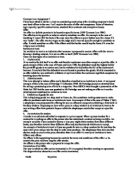Situations which have no contract
- Acceptance in Ignorance of the offer
An offer is effective when it is communicated to the offeree. This requirement generally does not give rise to the problems, but difficulty does arise in the following type of case. For instance, X offers HK$1,000 for the safe return of his missing dog. Y returns the dog but unaware of X’s offer. Is Y entitled to the money? A good argument can be made out to the effect that Y should be entitled to the money. X has got what he wanted and there seems no reason in justice why he should not be required to pay what he has publicly promised to pay. At the same time Y has performed a socially useful act in returning the dog and he should be rewarded for so doing. On the other hand, in the case of bilateral contract which imposes mutual obligations upon the parties, the effect of such a rule would be to subject the accepting party to obligations of which he was unaware. However, the rule which has been adopted in England is that a person who, in ignorance of the offer, performs the act or acts requested by the offeror is not entitled to sue as on a contract. An offer cannot be accepted by someone who is ignorant of the existence of the offer or by someone who does not have the offer in his mind when he does the act which he alleges constitutes the acceptance.
- Acceptance by Silence
The general rule is that acceptance of an offer will not implied from mere silence on the part of the offeree and that an offeror cannot impose a contractual obligation upon the offeree by stating that, unless the latter expressly rejects the offer, he will be held to have accepted it. The rationale behind this rule is that it is thought to be unfair to put an offeree to time and expense to avoid the imposition of unwanted contractual arrangements. In Felthouse v.Bindley case, the plaintiff and his nephew entered into negotiations for the sale of the nephew’s horse. The plaintiff stated that if he heard nothing further from his nephew then he considered that the horse was his at a price of ₤30 15s. The nephew did not respond to this offer but he decided to accept it and told the defendant auctioneer not to see the horse. Nevertheless, the auctioneer mistakenly sold the horse and so the plaintiff sued the auctioneer in conversion. The auctioneer argued that the plaintiff had no title to sue because his offer to buy the horse had not been accepted by his nephew and this argument was upheld by the court on the ground that the nephew’s silence did not amount to an acceptance of the offer.
- Uncertainty of an agreement
In order to constitute a valid contract, the parties must express their agreement in a form which is sufficiently certain. There are two types of uncertain agreement: Vagueness and Incompleteness.
--Vagueness
In the case of Scammell and Nephew Ltd v. Ouston, where the parties entered into an agreement to buy goods on ‘hire purchase’. It was held that this agreement was too vague to be enforced because there were many different types of hire purchase agreements in use, these agreement varied widely in their content and it was not clear what type of hire purchase agreement was envisaged. As a result, the courts are reluctant to find that an agreement is so vague that it cannot be enforced.
--Incompleteness
The agreement may be incomplete because the parties have failed to reach agreement upon a particular tissue.
Conclusion
The above situations are no contract. The valid contract has a properly communication of offeror and offeree. In order to have a valid agreement, the offer and acceptance should exist clearly. Otherwise the contract cannot be enforced by court.








